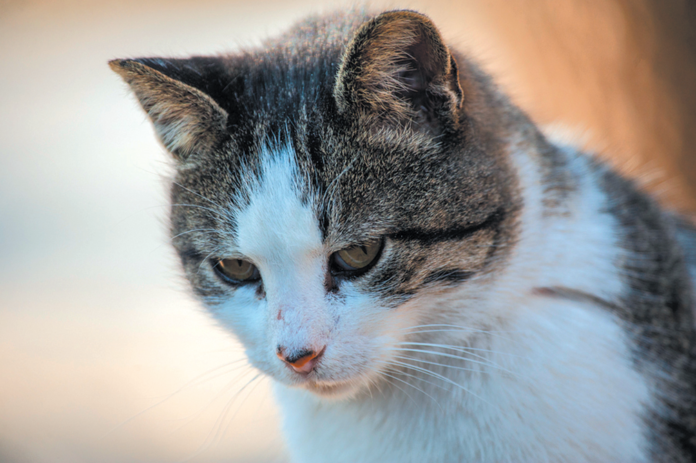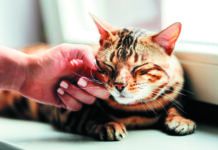There’s a belief in some circles that a cat can easily cope with her owner’s absence for long periods of time. The thinking is that when people head out, the pet is content to curl up in her favorite closet, or at her favorite window, and hang out by herself for as many hours as necessary. After all, in the wild, cats are often solitary predators. But when Brazilian researchers conducted a study in which they asked 130 owners of 223 cats to answer a questionnaire about their pets’ behavior in their absence, it turned out that almost one in seven of the cats was found to have exhibited one or more signs of separation-related problems indicative of separation anxiety. The problem signs, from most to least common, included destructive behavior, excessive vocalizations, urination in inappropriate places, depression/apathy, aggressiveness, and agitation/anxiety. The inappropriate urination tended to occur on the owner’s bedroom floor or bed, below the living room furniture, next to floor drains, and on carpets, sofas, pet owners’ clothes, and the kitchen sink. The new research squares with what many cat owners have observed on their own and what prior investigations have helped confirm: cats can and do bond with their people. One experiment found, for instance, that cats display more exploratory and playful behaviors when accompanied by their owners rather than when they are left alone or with someone they don’t know. And a number of studies taken together suggest that cats express more security and stability in their owners’ presence, and more anxiety and stress when their owners aren’t around.
Environmental factors that contribute to separation issues
In the latest study, signs of separation-related problems in felines were twice as common in homes without another cat — or dog — as in homes that had one or more other pets. It makes sense when you consider that even the company of an animal your cat might not like very much could be better company than none at all, especially over long stretches of many hours. Younger adults — those in the 18-35 group — were more apt to report having a pet with separation anxiety behavior than older people, perhaps because younger people have more erratic schedules and busier lives that don’t allow them to give cats the consistent schedules and attention they may crave. The amount of time spent away counted, too. Cats who stayed alone five to seven times a week were significantly more likely to have separation-related behaviors than cats who had human company more often. Cats never left alone at all were only one third as likely to demonstrate signs of separation anxiety as cats who spent time by themselves.
Caveats and takeaways
The study had limitations in that it was not always clear how owners ascertained what was going on in their absence. For instance, they could have heard from neighbors that their pet vocalized excessively once they left the house. Another possibility was that they lived with other people, but those people were not the pets’ primary go-to person so the cats acted out in front of them when their closest human companion was gone. It’s also possible, the researchers point out, that some of the behavior might have resulted from plain old boredom rather than feeling troubled about separation from people per se. Still, the results are consistent with animal behaviorists’ knowledge that house cats become accustomed to having people around and also need mental and physical stimulation. Thus, whether you’re home a lot with your cat or not, it’s important to make sure she has access to plenty of toys, including perhaps food puzzles that make “hunting” for meals a little more interesting and time-consuming. A second cat, if you’re up for it, might be a great idea, too. Finally, even if you’re home much of the time (or have been home more often lately than you generally are), your cat needs a good dose of “you.” It’s one thing to be under the same roof as your pet. It’s another to spend a little time shining a laser beam on a wall for her to chase, dragging a pull toy along the floor, petting her, brushing her. That is, you want to make sure she’s not alone all day when you are there.




